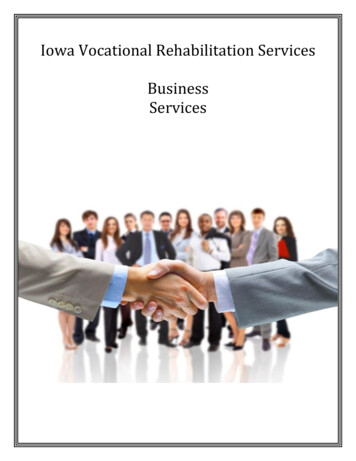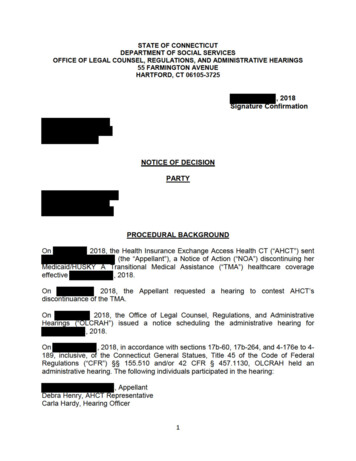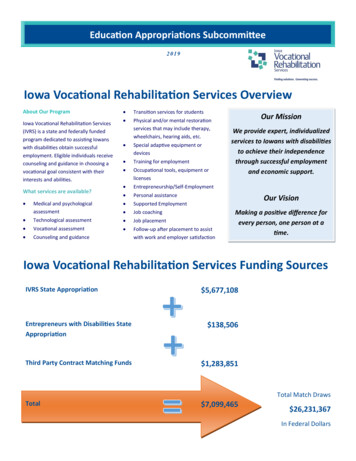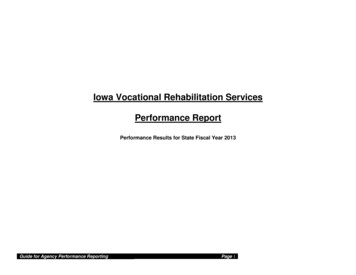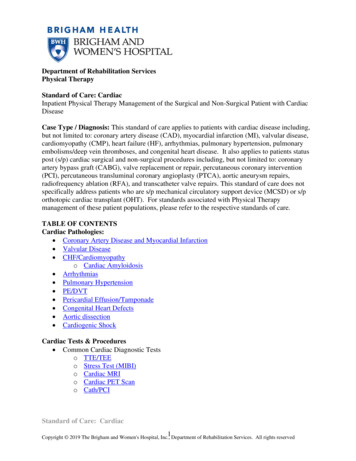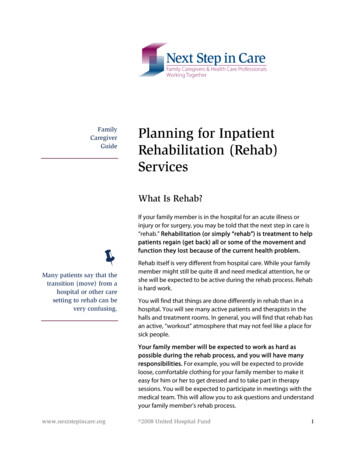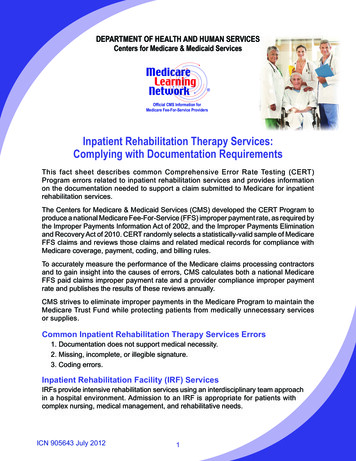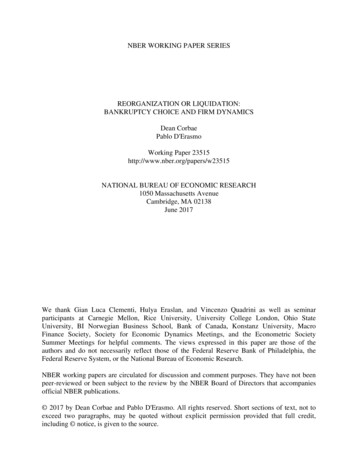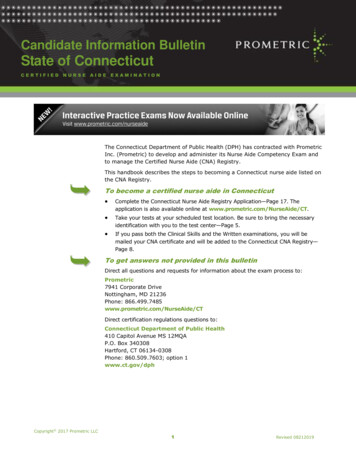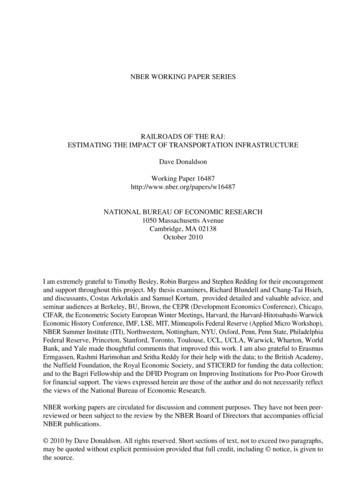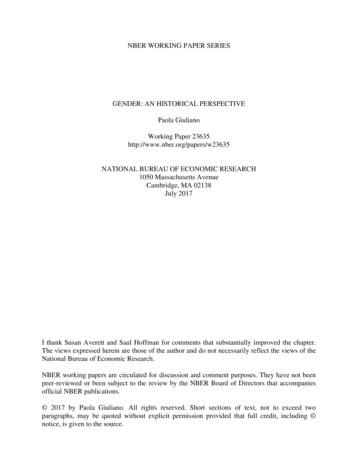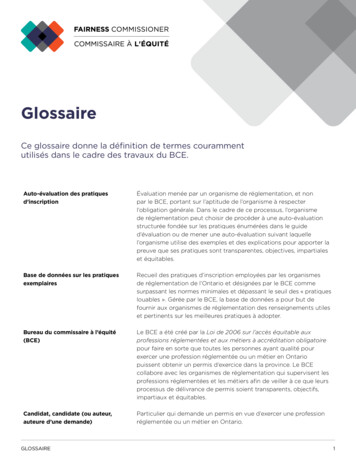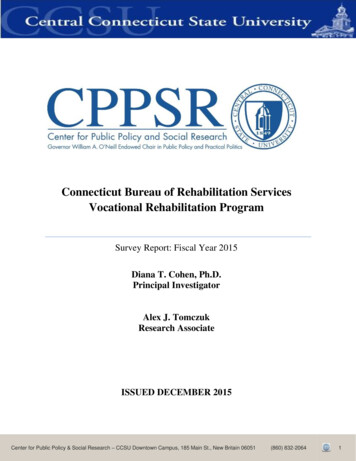
Transcription
Connecticut Bureau of Rehabilitation ServicesVocational Rehabilitation ProgramSurvey Report: Fiscal Year 2015Diana T. Cohen, Ph.D.Principal InvestigatorAlex J. TomczukResearch AssociateISSUED DECEMBER 2015Center for Public Policy & Social Research – CCSU Downtown Campus, 185 Main St., New Britain 06051(860) 832-20641
TABLE OF CONTENTSABOUT . 3VOCATIONAL REHABILITATION SERVICES PROGRAM . 3SURVEY OBJECTIVES . 3METHODOLOGY . 4DATA COLLECTED . 4EXECUTIVE SUMMARY . 4FINDINGS . 7SAMPLE DEMOGRAPHICS . 7SERVICES RECEIVED . 8INDIVIDUALIZED PLAN FOR EMPLOYMENT (IPE) RATINGS . 10COUNSELORS RATINGS . 11OVERALL RATINGS. 13UNSUCCESSFUL OUTCOMES . 15COMPARISON/CONNECTIONS . 16ANNOTATED QUESTIONNAIRE . 18Center for Public Policy & Social Research – CCSU Downtown Campus, 185 Main St., New Britain 06051(860) 832-20642
ABOUTThe Bureau of Rehabilitation Services (BRS) administers the Title I VocationalRehabilitation and Title VI Supported Employment (SE) programs of the RehabilitationAct of 1973, as amended.BRS receives federal funding from the Rehabilitation Services Administration (RSA),Office of Special Education and Rehabilitative Services (OSERS) at the US Departmentof Education. The obligations for the use of this federal funding are defined in the BRSState Plan (see State Plan on the BRS website: http://www.ct.gov/brs/).The Department of Rehabilitation Services (DORS) is the designated state agency thatoversees BRS and the vocational rehabilitation and supported employment programs inConnecticut.1VOCATIONAL REHABILITATION SERVICES PROGRAMThe goal of the vocational rehabilitation (VR) program is to assist individuals with nonsignificant and significant physical and mental disabilities to prepare for, obtain andmaintain employment. Through the provision of individualized services, persons withdisabilities who are eligible for vocational rehabilitation are supported in planning for andachieving their job goals.To be eligible for the VR program, an individual must have a physical or mentalcondition which poses a substantial barrier to employment, and must require VR servicesin order to prepare for, find and succeed in employment.The VR program serves persons with all disabilities except legal blindness. Individualswith legal blindness are served by the Bureau of Education and Services for the Blind(BESB), also under DORS, and their website is located at www.besb.state.ct.us.2THE STATE REHABILITATION COUNCILThe State Rehabilitation Council (SRC) includes consumers, family members and VRprofessionals who are appointed by the Governor to provide assessment, advice andrecommendations to BRS regarding coordination and effectiveness of programs andstrategies which promote competitive employment for persons with disabilities.SURVEY OBJECTIVESIn response to the SRC’s goal to assess the effectiveness and delivery of VR servicesprovided by BRS, the SRC collaborated with BRS to commission the Center for PublicPolicy and Social Research (CPPSR) at Central Connecticut State University (CCSU) toconduct a customer satisfaction survey of VR recipients for fiscal year 2015. The purposeof this survey is to evaluate the job search services that consumers/participants receivedfrom the VR program at BRS.1Language sourced from the BRS website: http://www.ct.gov/brs/cwp/view.asp?a 3890&q 456864Language sourced from the BRS website: http://www.ct.gov/brs/cwp/view.asp?a 3890&q 4614162Center for Public Policy & Social Research – CCSU Downtown Campus, 185 Main St., New Britain 06051(860) 832-20643
METHODOLOGYTwo-hundred and three consumer interviews were conducted from August 10th throughSeptember 24th, 2015. The construction of the survey instrument was a collaborativeeffort between the SRC, BRS and CPPSR. The list of consumers from which this surveydata is drawn was provided by BRS. That list of 600 individuals represents a smallsampling of the 8,672 current and former VR consumers that BRS served in fiscal year2015. Consumer names were pulled from all regions.Of the 600 consumer names provided for the survey, 75 individuals chose not to respondto the survey and 88 individuals could not be reached due to an out-of-service number, aninaccurate number, or use of a privacy device. Three individuals were either deceased orincarcerated, while six others had language barriers. The remaining 225 consumers didnot answer the phone following numerous attempts, throughout multiple days andevenings. CPPSR called each consumer a minimum of seven times, though in most cases,attempts reached upwards of ten calls.Out of the respondents who CPPSR was able to reach, this survey has a 6% margin oferror at the 95% confidence interval. This means that statistical differences outside of the /- 6% margin of error will only exist approximately 5% of the time.CPPSR conducted the survey over the phone and recorded consumer answers exactly asstated. Please see the Annotated Questionnaire beginning on page 18 to see the surveyinstrument utilized in the interviews.DATA COLLECTEDThe Center for Public Policy and Social Research collected two forms of data: Qualitative: Participant comments, recorded and reported verbatim. Quantitative: Participant responses utilizing one of the provided answer options.EXECUTIVE SUMMARYDemographicsThe strong majority (71%) of consumers surveyed came to BRS primarily to seek help infinding a job. Consumers also sought assistance from BRS for a hearing aid (16%),education services, and job training services (7%). Of the sample names provided, thesurvey participants were predominantly young, with ages 17 through 29 years old totalingto 42% of those surveyed. Most participants lived in the New Haven (40%) and Hartford(29.5%) Counties, which coincides with the New Haven (19%) and Hartford (15.5%)BRS offices being the most frequently visited locations. Collectively, these locations totalto over one-third (34.5%) of the offices cited for receiving of services. Nearly four-in-ten(38%) of BRS survey participants identified as having a mental and/or emotionalCenter for Public Policy & Social Research – CCSU Downtown Campus, 185 Main St., New Britain 06051(860) 832-20644
limitation. In combination with thinking (17%) and hearing (18%) limitations, thesedisabilities were identified by more than seven-in-ten (73%) of those surveyed.SatisfactionThe data retrieved from those surveyed demonstrates a relationship between satisfactionand three primary factors: fulfillment of needs and/or expectations, knowledgeable and/orcaring counselors, and timely service.Of the consumers offering a “very satisfied” (8-10) overall rating of BRS, half (50%) ofthem identified that his/her needs and/or expectations were met. One consumercommented that “they [BRS] were very helpful and helped me develop skills for me tofind a job.” Another emphasized that “they [BRS] pointed me in a direction in a timewhere I had none.”Over three-quarters (76.5%) of consumers issued a “very satisfied” (8-10) ratingregarding his/her overall satisfaction working with his/her counselor. Consumers enjoyedthe “personal flexibility” of his/her counselor and the thoughtfulness of his/her counselor.One consumer further commented that “I wasn’t judged or looked down upon.”Although timely service was only sporadically cited as the reasoning for a consumer’s“very satisfied” (8-10) rating, with a small percentage of consumers indicating such, itwas the third most popular citation. Nearly one-in-ten (8%) consumers identified timelyservice as the main reasoning for satisfaction with the services received. One consumerstated that “it was fast, they cared a lot, and they helped me find a job AND keep it.”DissatisfactionThe data collected from those interviewed demonstrates a relationship betweendissatisfaction and three primary factors: unsuccessful job outcomes, outcomes achievedin an unreasonable timeframe, and miscommunication.The majority of consumers surveyed were/are receiving job search assistance from BRS;thus, it is not surprising that unsuccessful job outcomes were largely cited as a reason foroverall consumer dissatisfaction. One consumer stated that “I would rather just leaveBRS,” while an older woman emphasized the impact of age and disability in the hiringprocess. “They [hiring managers] were not interested in hiring an older woman. I am notthe norm and as an older person, I believe that placement services need to be available.”Of those found eligible for services, over one-third (35%) of consumers surveyedindicated that it took 3-5 weeks to determine eligibility. Furthermore, over one-tenth(14%) of consumers believed that the initial meeting with BRS and the steps takenafterwards were not done in a reasonable amount of time. A participant commented that“it took over a month for each step [to be completed]” and another frustrated consumersaid “I felt like they were too busy for me.”Center for Public Policy & Social Research – CCSU Downtown Campus, 185 Main St., New Britain 06051(860) 832-20645
Over nine-in-ten (90.5%) consumers confirmed that his/her rights and responsibilitieswere read to him/her. However, nearly three-in-ten (29%) did not know what to do if theywere unhappy or disagreed with a decision. This notion of miscommunication isemphasized with a consumer’s following comment: “my needs were ignored. I askedabout trade school and some other things, but they just brushed it off. I brought a coupleof different things to my counselor’s attention but they did nothing to help me.” Anothersurvey participant offered insight into how BRS operations affect communication bystating that “it was hard to get paper through the many levels of bureaucracy.”Individualized Plan for Employment (IPE)/CounselorAcross the board, BRS trended towards “very satisfied” (8-10) ratings; however, IPEratings and counselor ratings saw some negative feedback.Slightly less than one-in-four (24.5%) consumers indicated that he/she did not participatein the development of his/her IPE. One consumer indicated that “physical therapy heldthis process up,” while another was frustrated that BRS could only provide help withlanding a job rather than volunteer work. Furthermore, a consumer found that his/her IPEdid not fit his/her circumstances by adding that “I am not sure that BRS has very muchexperience working with people with my skill set and education level.”Roughly one-in-twenty (6.5%) consumers issued a “very dissatisfied” (1-3) rating of theircounselor, for which a number of reasons were cited. One consumer stated that “mycounselor insisted that despite my education that I do clerical work — I have twoMaster’s Degrees.” Likewise, low satisfaction (“very dissatisfied”) ratings of counselors’professionalism and cultural sensitivity were evenly cited 3% of the time. A participantcommented that “some programs were helpful and some were so unprofessional that theywere actually offensive.” Another consumer said that “my counselor would say, ‘comeon, you’re from the Caribbean, you should know how to work hard.”ReferralsNine-in-ten (90%) consumers would recommend BRS to a family and/or friend; however,nearly one-tenth (8.5%) of consumers would not make such a recommendation (1.5% ofthose surveyed did not know or chose not to comment). Among the reasons cited for notrecommending BRS to a friend, timeframe for an outcome was the primary factor. “Ihaven’t had an interview and it was a waste of time. There was no support” declared oneindividual. Another consumer believed that the case load for BRS employees was toomuch: “I don’t feel like they really have time to help everyone.”Center for Public Policy & Social Research – CCSU Downtown Campus, 185 Main St., New Britain 06051(860) 832-20646
FINDINGSSAMPLE DEMOGRAPHICS Most of the surveyed consumers (40%) reside in New Haven County. Nearlythree-in-ten (29.5%) reside in Hartford County, while just shy of one-fifth (19%)call Fairfield County home.n 199CountyNew HavenHartfordFairfieldLitchfieldTollandNew LondonMiddlesexWindhamNo response (volunteered)Percentage40%28%20%4%2.50%2.50%1%1%1% The New Haven BRS Office was the most visited location with roughly one-infive consumers (19%) using this location. Hartford (15.5%), Bridgeport (13.5%),Waterbury (9.5%), and Ansonia (6.5%) round out the top five most frequentlyvisited offices.n 199AGE GROUPBREAKDOWN42%17 - 29 years old8%30 - 39 years old14%40 - 49 years old17%50- 59 years old14%60 - 69 years old5%No response (volunteered) VR consumers are trending towards a younger age. Most of the surveyedconsumers (42%) fall between the age of 17 and 29 years. Slightly more thanthree-in-ten individuals (31%) are over the age of 50.Center for Public Policy & Social Research – CCSU Downtown Campus, 185 Main St., New Britain 06051(860) 832-20647
n 199PRIMARY DISABILITY?Mental and/or Emotional LimitationsHearing LimitationsLimitations with ThinkingPhysical LimitationsCommunication LimitationsVision LimitationsDon't know (volunteered)No response (volunteered)BREAKDOWN38%18%17%14%7.5%1.5%1.5%2.5% The most commonly cited primary disability was mental and/or emotionallimitations (38%). Hearing limitations (18%) and thinking limitations (17%)were nearly equally cited as the next two primary disabilities.SERVICES RECEIVED A strong majority of consumers came to BRS to receive help finding a job (71%).As a distant second response, consumers reported coming to BRS to receivehearing aids (16%). Furthermore, a small minority came to receive educationand/or training to get a job (7%). More than nine-in-ten consumers (95%) reported being able to find the BRSoffice, while the remainder (4%) indicated that they could not find the office ordid not comment (1%). More than nine-in-ten consumers (94%) indicated that the BRS office wasaccessible, while less than one-in-ten (5.5%) felt that the office was inaccessible.Among that group, one person indicated that “the elevator was alwaysmalfunctioning.” Another offered that “there was a lot of trouble with theintercom system.” Over eight-in-ten (85%) reported receiving an explanation of the servicesavailable to them. More than one-in-ten consumers (14%) felt that such anexplanation was not given.n 202BRS STATUS?BREAKDOWN47%Applied for services & currently receiving services23%Applied for services, but not yet receiving them21%No longer receiving services & case closed successfully8%No longer receiving services & case closed unsuccessfully1%Don't now (volunteered)0%No response (volunteered)Center for Public Policy & Social Research – CCSU Downtown Campus, 185 Main St., New Britain 06051(860) 832-20648
When consumers were asked about their current status with BRS, most (47%)reported that they applied for services and were currently receiving them. Slightlyless than one-quarter (23%) indicated that they applied for services, but were notyet receiving them. More than one-fifth (21%) of consumers reported that theywere no longer receiving services and that their case was closed successfully. Theremaining consumers were no longer receiving services and their cases wereclosed unsuccessfully (8%). Slightly less than nine-in-ten consumers (87%) felt that they were found eligiblefor services within a reasonable time. Just shy of one-in-ten (8%) indicated thatthis timeframe was unreasonable, with one consumer commenting that “it wasreally hard to get an appointment and then I had to see several people.” Anotherindividual offered that, “I was frustrated with the person assigned to me. I wasn’tgetting a response within a reasonable time.”n 180HOW MANY WEEKS FOR ELIGIBILITY?2 weeks or less3-5 weeks6-8 weeksMore than 9 weeksDon’t know (volunteered)No response (volunteered)PERCENTAGE23%35%12%8%21%1% Slightly more than one-third (35%) of consumers indicated that it took 3-5 weeksto determine eligibility, which represents the most commonly cited timeframe foreligibility determination. Over four-in-five consumers (81%) indicated that there was a reasonable amountof time between the initial meeting with BRS and the next step taken. Roughlythree-in-twenty (14%) felt that this wait was unreasonable. One such consumerindicated that he/she “fell through the cracks while someone was changing theirposition.” Another felt that BRS had a high caseload that impacted the quality ofservices. A third individual referenced the flexibility of BRS by stating that“working around my schedule and the BRS schedule was really hard.” Over nine-in-ten (90.5%) consumers indicated that their VR program rights andresponsibilities were explained to them. Roughly one-in-twenty (5.5%) indicatedthat these rights and responsibilities were not explained. One individual, citingthat his/her rights and responsibilities were not explained, stated the following: “Iasked questions and they never explained anything.” Another consumer echoedthis theme by claiming that “they never explained much to me, [they] just said‘sign here.’”Center for Public Policy & Social Research – CCSU Downtown Campus, 185 Main St., New Britain 06051(860) 832-20649
Just shy of nine-in-ten (88.5%) felt that they fully understood VR program rights.A very small minority (4.5%) indicated that they did not fully understand theserights. One such consumer explained that “my disability gives me a hard timeunderstanding things.” Another person felt that “it was just all complicated.” Roughly two-thirds (64%) indicated that they knew what to do if they wereunhappy with services or if they disagreed with a decision from BRS. Nearlythree-in-ten (29%) mentioned that they did not know what do in such a situation.The remainder of consumers (7%) did not know how to answer the question. Oneconsumer mentioned that he/she “qualified and met some opportunities, but theydid not meet my needs. After the last opportunity, BRS called and just closed mycase. I didn’t know what to do.”INDIVIDUALIZED PLAN FOR EMPLOYMENT (IPE) RATINGS Over seven-in-ten (71%) reported participating in the development of their IPE.Nearly one-quarter of consumers (24.5%) did not participate in development ofthe IPE. The remaining participants (4.5%) were unable to answer the question.One consumer, who did not participate in the development of his/her IPE,attributed it to missing the meeting that covered this process. Another echoed thisidea by saying that he/she “laid down in bed for five months. I have basicallybeen immobile since my condition developed, so there’s nothing I can do.” The majority of consumers (55%) issued a high satisfaction rating (“verysatisfied”) regarding the extent to which their counselor helped them develop theirIPE. About one-quarter of survey participants (26%) offered a neutral rating,while slightly more than one-in-twenty (7%) issued a l
Policy and Social Research (CPPSR) at Central Connecticut State University (CCSU) to conduct a customer satisfaction survey of VR recipients for fiscal year 2015. The purpose of this survey is to evaluate the job search services that consumers/participants received from the VR program at BRS.
